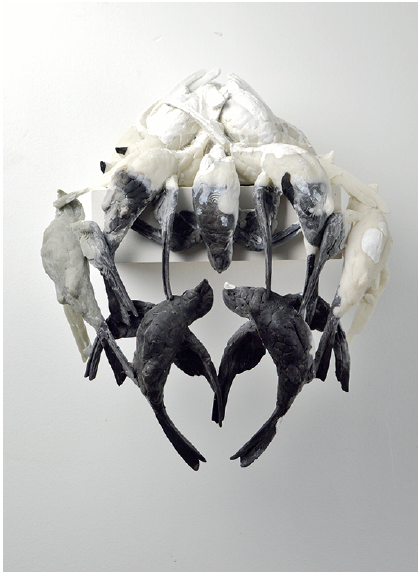Nicholas Crombach
At some moment in our prehistor y, human beings enlisted animals to stand in corporeally for our own concerns, and we have mapped their furry, feathery bodies, living or dead, with our social and political imaginaries ever since. Most of the works in Nicholas Crombach’s recent exhibition at Art Mûr, “Behind Elegantly Carved Wooden Doors,” draw freely from these traditions, even as they question them.
The wooden doors of the title are surely those of the English country house, where idealized animals symbolize human power, especially elite male power as it has been refined throughout Europe since the Middle Ages: game paintings, hunting trophies, heraldry, etc. Here, Crombach has created a great abattoir of animal figures in paint, polyurethane, gypsum and other materials. The excess or absurdity that imbues his works speaks to the absurdity of the visual traditions they draw on—and of the power relations these traditions were created to buttress and celebrate.

Nicholas Crombach, Survival of the Fittest, detail, 2016, polyurethane resin, paint, Houdon Ecorché reproduction, 30 x 41 x 76 cm. Images Art Mûr, Montreal.
One of Crombach’s most striking pieces, Inanimate Beings, is a grisly array of white polyurethane fowls and hares on a shelf, accented in places in blue and pink paint. Wings, necks and heads curl about ornamental scrollwork, forming a symmetrical tableau crowned with an upside-down goose, its wings spread crosswise. Cadaverous and detailed, in its spectacular symmetry the work gestures at heraldry. A similar pileup, Nature Morte, is painted in pinks, yellows and browns, and crowned with a russet-coloured corona of lace.
Another work of gruesome beauty, Sparrows, operates according to similar logics of excess, as black-and-white birds heaped upon a shelf seem to fall off. Piled or in fall, the birds remain in close symmetry. Other works are more restrained. In Squirrel Skin, a small, wall-mounted work in resin, a lace pattern has seemingly been pressed into the squirrel’s furry flesh. Witness the power of animal bodies as a visual vocabulary: even the humble figure (though simulated) of a small beast illustrates powerfully the contradiction between bourgeois social propriety and the abjection of morbidity.

Sparrows, 2016, polyurethane resin, pigment, paint, 30 x 23 x 15 cm.
Crombach also portrays human figures, fashioned from gypsum, in a seemingly classicizing style. In Diana and Actaeon, the two mythological characters face one another, naked, each almost a metre high, atop a built frame of unfinished wood. Actaeon holds a stag’s rack, while Diana, accompanied by two attentive dogs, carries a bow. A closer look shows that what seemed like an idealized classical scene becomes a tawdrier, compromised affair. The goddess appears middle-aged, unathletic, nonplussed, her bowstring snapped. Whatever modesty, if indeed it was that, that led Diana to transform Actaeon into a deer is gone. Actaeon is similarly out of training and looking quite vexed, as though lately returned to human form, come back to tell off Diana and reclaim his dogs.
Survival of the Fittest presents a reproduction of Houdon’s famous écorché, knocked onto his side by a checkmated king and perched upon by a dozen polyurethane parrots. The écorché (a “flayed man” image used for anatomical study) is an uneasy tradition, ever caught between its purpose of modelling ideal forms and its minute but inevitable inaccuracies. Monty Python’s famous “Dead Parrot” sketch pushed itself into my mind: the birds, tinted in subdued hues, seem to occupy a shadowy but quietly comical middle ground between life—a parrot’s normally bright colouration—and death—the white écorché figure.
The bodies represented in Crombach’s show include both those of “hunted” (game birds, hares) and of “hunters” (dogs—but chiefly humans). Yet the systems of power presented here do not seem to function properly; even the hunters seem fatigued, disinterested. Power, it seems, is disappointing lukewarm. This is most evident in certain works that Crombach presents as children’s toys. A painted rocking horse, End of the Chase, slumps forward, collapsing in fatigue. Some wheeled pull-wagons, Fair Game, bear flat, wooden cut-outs of game birds in various positions, including one dead on its back. The toy pieces locate childhood as a place where these conditions—the absurd excesses throughout the exhibition— are taught and normalized, where humanity’s God-given birthright, dominion over animals, is revealed as meaningless mastery over an animal kingdom that is spent and defeated, a simulacrum of itself.

Hunter #1, 2016, gypsum, 11 x 27 x 8 cm.
There is a scene toward the end of the third season of Downton Abbey where the Crawley family visits friends, the Marquess of Flintshire, nicknamed “Shrimpie,” and family in Scotland. On the entry hall’s walls, dozens of rifles are arranged in two great sunbursts or roundels, between them a statue of a rampant stag. But behind this murderous panorama, the household is broke, the patrician Shrimpie a doomed man in desperate straits.
Like Crombach’s exhibition, it’s a moment especially pertinent to our neoliberal capitalist present. We are hunters, sure, but now we are also Shrimpies. Rather than power and plenty, our inheritance comprises empty promises: politics without solutions, work without advancement, an increasingly hostile natural environment, neither future nor end in sight. The animal kingdom includes our bodies, too; what will become of them, no one can say. ❚
“Behind Elegantly Carved Wooden Doors” was exhibited at Art Mûr, Montreal, from November 4 to December 20, 2017.
Edwin Janzen is a Winnipeg-born writer, editor and artist living in Montreal.

